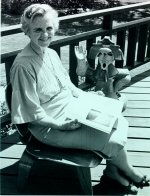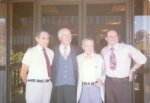
The Center for the Study of Democratic Institutions (1964-1967)
1964
On February 2, Pauling speaks at a meeting that the officers and staff of the Center for the Study of Democratic Institutions have organized to honor him as a new colleague and associate. Pauling takes as his theme, "Science and Peace," from his recent Nobel lecture.
While continuing to live in Pasadena during the spring, Pauling publishes his paper on the electroneutrality principle and the structure of molecules.
He publishes in Nature a paper on the nature of the iron-oxygen bond in oxyhemoglobin. It is frequently cited by many scientists in the years after its publication.
During the summer, Linus and Ava Helen Pauling begin planning an elaborate new home for their ranch property (they have been living in a primitive cabin).
In August, the Paulings move to Santa Barbara, where they settle into a small house they have purchased at 794 Hot Springs Road. Pauling takes up his position as Research Professor in the Physical and Biological Sciences at the Center for the Study of Democratic Institutions.
In September, a forest and brush fire comes within a hundred yards of their house. They load most of their furniture, books, and papers into two moving vans and several cars, and they then take them to a place of safety. Robert Hutchins, who founded the Center for the Study of Democratic Institutions in 1959, loses his home, books, and papers in this fire that destroys about 80 houses in Santa Barbara. Fortunately, the house of the Paulings escapes the blaze, and after three days, they bring everything back.
Linus and Ava Helen Pauling spend one month (October 15 to November 15) in Australia at the invitation of the Australian Congress for International Cooperation and Disarmament. They participate in the Congress, and Pauling gives lectures in various institutions on science and medicine as well as on peace.
1965
In January, Pauling applies for a Guggenheim Fellowship to support a theoretical physicist who will collaborate with him in some theoretical studies on the structure of atomic nuclei. He later receives this Guggenheim Fellowship, his second.
"The International Convocation to Examine the Requirements of Peace" is sponsored by the Center for the Study of Democratic Institutions in New York City from February 18 to 20 to discuss Pope John XXIII’s encyclical Pacem in Terris. Pauling addresses the Pacem in Terris Convocation on February 18.
On March 30, Pauling endorses the stand of the Reverend Martin Luther King, Jr. in calling for a national and international boycott and embargo of the State of Alabama until fifty percent of the Negro citizens of voting age are registered.
On August 12, eight Nobel Peace Prize winners issue an urgent appeal to world leaders for an immediate ceasefire and political settlement of the war in Vietnam. Pauling, Schweitzer, and Martin Luther King are among the signers.
At an October meeting of the National Academy of Sciences in Seattle, Washington, Pauling announces his new theory of the structure of the atomic nucleus. Through a largely empirical method, he develops a simple cluster model of nuclei that accounts for several nuclear properties, for example, asymmetric fission. His new theory incorporates features of the older shell and liquid-drop theories. The basic idea of his theory is that protons and neutrons are combined into spherons, the most important of which are aggregates of two neutrons and two protons, called the helion or alpha particle. He publishes "The Close-Packed-Spheron Theory and Nuclear Fission" in Science on October 15.
Pauling and Emile Zuckerkandl publish "Evolutionary Divergence and Convergence in Proteins" in the book Evolving Genes and Proteins, edited by V. Bryson and H.J. Vogel. This paper on molecules as documents of evolutionary history turns out to be one of the most influential of Pauling’s later career and in the formative period of Dr. Zuckerkandl’s career.
1966
Pauling and his wife begin spending about two weeks per month in Santa Barbara and two weeks per month in their new home at the ranch on the Big Sur coast.
On the occasion of his reception of the Carl Neuberg Medal for 1966 in New York City, Pauling lectures on "Science and World Problems." On April 4, he receives a letter from Irwin Stone, who was struck by Pauling’s mention in his talk that he would like to live for another fifteen years. Stone wants Pauling to live even longer than that and he believes that he has a way to accomplish this—a high-level regimen of vitamin C (ascorbic acid). Stone sends Pauling some material about his medical ideas, and Pauling and his wife begin taking large doses of vitamin C. They experience an improvement in health and a decrease in the number and severity of their colds. Stone’s letter marks the beginning of Pauling’s fascination with ascorbic acid and its role in human health.
On December 3, Pauling receives the first Pauling Medal of the American Chemical Society’s Oregon and Puget Sound Sections in recognition of his distinguished achievement in chemistry.
1967
On February 2 and 3, Pauling delivers the Azad Memorial Lectures in New Delhi, India.
On May 17, he gives the 29th William Henry Snyder Lecture, "The Challenge of Scientific Discovery," in Los Angeles.
In the summer, Pauling asks for and receives a one-year leave of absence from the Center for the Study of Democratic Institutions to accept a position as professor of chemistry at the University of California in San Diego. The reason for his leave is his lonesomeness because of his lack of contact with other scientists. He also wants to return to supervising experimental work. His appointment is for one year, but the possibility exists for it to be continued. His appointment becomes effective on July 1.
In September, Linus and Ava Helen Pauling move to La Jolla, near San Diego, and Pauling takes up his duties as professor of chemistry.
He publishes The Chemical Bond, a shortened version of The Nature of the Chemical Bond, with Cornell University Press.
In November, he receives the Roebling Medal of the American Mineralogical Society in New Orleans.
In December, Ava Helen Pauling is hospitalized due to a small stroke she suffers. She recovers completely, with no paralysis and no interference with her speech or reflexes.
From December through January, Pauling makes a lecture tour of India. He and his wife visit South India, Kerala, and Ceylon. They visit their son Linus Jr. in Honolulu both on the way to India and on the way back.
Table of Contents
- The Ancestry of Linus Pauling (The Paulings)
- The Ancestry of Linus Pauling (The Darlings)
- Linus Pauling's Childhood (1901-1910)
- Linus Pauling's Adolescence (1910-1917)
- Pauling's Years as an Undergraduate at Oregon Agricultural College, Part 1 (1917-1919)
- Pauling's Years as an Undergraduate at Oregon Agricultural College, Part 2 (1919-1922)
- Linus Pauling as a Graduate and Postdoctoral Student at the California Institute of Technology, Part 1 (1922-1923)
- Linus Pauling as a Graduate and Postdoctoral Student at the California Institute of Technology, Part 2 (1924-1926)
- A Guggenheim Fellow in Europe during the Golden Years of Physics (1926-1927)
- Early Career at the California Institute of Technology (1927-1930)
- Pauling's Great Years of Achievement in Structural Chemistry, Part 1 (1931-1932)
- Pauling's Great Years of Achievement in Structural Chemistry, Part 2 (1933-1935)
- Pauling's Increasing Involvement in Molecular Biology (1936-1939)
- The War Years, Part 1 (1940-1942)
- The War Years, Part 2 (1943-1945)
- The Postwar Years, Part 1 (1946-1947)
- The Postwar Years, Part 2 (1948-1949)
- Proteins, Passports, and the Prize (1950-1954)
- Increasing Involvement in World Peace, Part 1 (1955-1958)
- Increasing Involvement in World Peace, Part 2 (1959-1963)
- The Center for the Study of Democratic Institutions (1964-1967)
- The University of California, San Diego (1968-1969)
- Stanford University (1969-1972)
- An Institute for Science and Orthomolecular Medicine, Part 1 (1973-1977)
- An Institute for Science and Orthomolecular Medicine, Part 2 (1978-1981)
- The Years Alone: Pauling after the Death of Ava Helen, Part 1 (1982-1988)
- The Years Alone: Pauling after the Death of Ava Helen, Part 2 (1989-1994)
- About the Author



